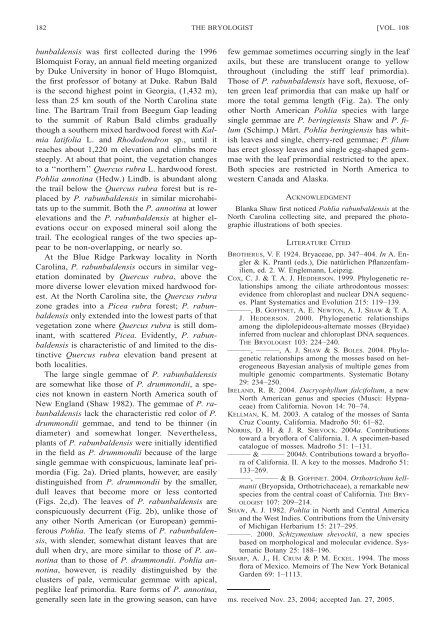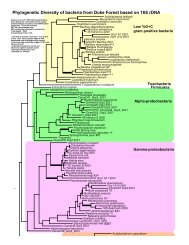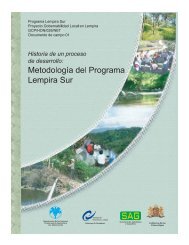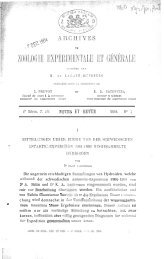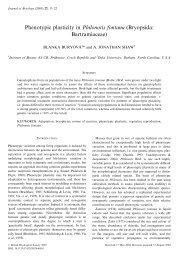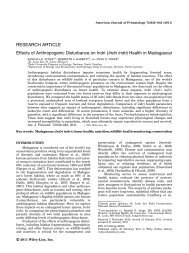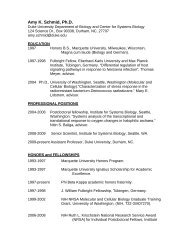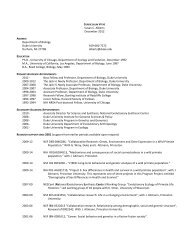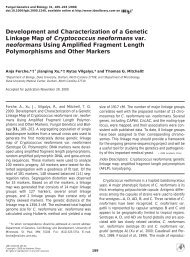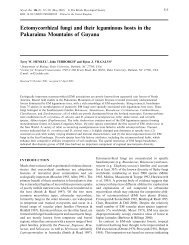THE BRYOLOGIST - Duke Biology Department - Duke University
THE BRYOLOGIST - Duke Biology Department - Duke University
THE BRYOLOGIST - Duke Biology Department - Duke University
Create successful ePaper yourself
Turn your PDF publications into a flip-book with our unique Google optimized e-Paper software.
182 <strong>THE</strong> <strong>BRYOLOGIST</strong><br />
[VOL. 108<br />
bunbaldensis was first collected during the 1996<br />
Blomquist Foray, an annual field meeting organized<br />
by <strong>Duke</strong> <strong>University</strong> in honor of Hugo Blomquist,<br />
the first professor of botany at <strong>Duke</strong>. Rabun Bald<br />
is the second highest point in Georgia, (1,432 m),<br />
less than 25 km south of the North Carolina state<br />
line. The Bartram Trail from Beegum Gap leading<br />
to the summit of Rabun Bald climbs gradually<br />
though a southern mixed hardwood forest with Kalmia<br />
latifolia L. and Rhododendron sp., until it<br />
reaches about 1,220 m elevation and climbs more<br />
steeply. At about that point, the vegetation changes<br />
to a ‘‘northern’’ Quercus rubra L. hardwood forest.<br />
Pohlia annotina (Hedw.) Lindb. is abundant along<br />
the trail below the Quercus rubra forest but is replaced<br />
by P. rabunbaldensis in similar microhabitats<br />
up to the summit. Both the P. annotina at lower<br />
elevations and the P. rabunbaldensis at higher elevations<br />
occur on exposed mineral soil along the<br />
trail. The ecological ranges of the two species appear<br />
to be non-overlapping, or nearly so.<br />
At the Blue Ridge Parkway locality in North<br />
Carolina, P. rabunbaldensis occurs in similar vegetation<br />
dominated by Quercus rubra, above the<br />
more diverse lower elevation mixed hardwood forest.<br />
At the North Carolina site, the Quercus rubra<br />
zone grades into a Picea rubra forest; P. rabunbaldensis<br />
only extended into the lowest parts of that<br />
vegetation zone where Quercus rubra is still dominant,<br />
with scattered Picea. Evidently, P. rabunbaldensis<br />
is characteristic of and limited to the distinctive<br />
Quercus rubra elevation band present at<br />
both localities.<br />
The large single gemmae of P. rabunbaldensis<br />
are somewhat like those of P. drummondii, a species<br />
not known in eastern North America south of<br />
New England (Shaw 1982). The gemmae of P. rabunbaldensis<br />
lack the characteristic red color of P.<br />
drummondii gemmae, and tend to be thinner (in<br />
diameter) and somewhat longer. Nevertheless,<br />
plants of P. rabunbaldensis were initially identified<br />
in the field as P. drummondii because of the large<br />
single gemmae with conspicuous, laminate leaf primordia<br />
(Fig. 2a). Dried plants, however, are easily<br />
distinguished from P. drummondii by the smaller,<br />
dull leaves that become more or less contorted<br />
(Figs. 2c,d). The leaves of P. rabunbaldensis are<br />
conspicuously decurrent (Fig. 2b), unlike those of<br />
any other North American (or European) gemmiferous<br />
Pohlia. The leafy stems of P. rabunbaldensis,<br />
with slender, somewhat distant leaves that are<br />
dull when dry, are more similar to those of P. annotina<br />
than to those of P. drummondii. Pohlia annotina,<br />
however, is readily distinguished by the<br />
clusters of pale, vermicular gemmae with apical,<br />
peglike leaf primordia. Rare forms of P. annotina,<br />
generally seen late in the growing season, can have<br />
few gemmae sometimes occurring singly in the leaf<br />
axils, but these are translucent orange to yellow<br />
throughout (including the stiff leaf primordia).<br />
Those of P. rabunbaldensis have soft, flexuose, often<br />
green leaf primordia that can make up half or<br />
more the total gemma length (Fig. 2a). The only<br />
other North American Pohlia species with large<br />
single gemmae are P. beringiensis Shaw and P. filum<br />
(Schimp.) Ma˚rt. Pohlia beringiensis has whitish<br />
leaves and single, cherry-red gemmae; P. filum<br />
has erect glossy leaves and single egg-shaped gemmae<br />
with the leaf primordial restricted to the apex.<br />
Both species are restricted in North America to<br />
western Canada and Alaska.<br />
ACKNOWLEDGMENT<br />
Blanka Shaw first noticed Pohlia rabunbaldensis at the<br />
North Carolina collecting site, and prepared the photographic<br />
illustrations of both species.<br />
LITERATURE CITED<br />
BRO<strong>THE</strong>RUS, V. F. 1924. Bryaceae, pp. 347–404. In A. Engler<br />
& K. Prantl (eds.), Die natürlichen Pflanzenfamilien,<br />
ed. 2. W. Englemann, Leipzig.<br />
COX, C. J. & T. A. J. HEDDERSON. 1999. Phylogenetic relationships<br />
among the ciliate arthrodontous mosses:<br />
evidence from chloroplast and nuclear DNA sequences.<br />
Plant Systematics and Evolution 215: 119–139.<br />
———, B. GOFFINET, A.E.NEWTON, A.J.SHAW &T.A.<br />
J. HEDDERSON. 2000. Phylogenetic relationships<br />
among the diplolepideous-alternate mosses (Bryidae)<br />
inferred from nuclear and chloroplast DNA sequences.<br />
<strong>THE</strong> <strong>BRYOLOGIST</strong> 103: 224–240.<br />
———, ———, A. J. SHAW &S.BOLES. 2004. Phylogenetic<br />
relationships among the mosses based on heterogeneous<br />
Bayesian analysis of multiple genes from<br />
multiple genomic compartments. Systematic Botany<br />
29: 234–250.<br />
IRELAND, R. R. 2004. Dacryophyllum falcifolium, a new<br />
North American genus and species (Musci: Hypnaceae)<br />
from California. Novon 14: 70–74.<br />
KELLMAN, K. M. 2003. A catalog of the mosses of Santa<br />
Cruz County, California. Madroño 50: 61–82.<br />
NORRIS, D.H.&J.R.SHEVOCK. 2004a. Contributions<br />
toward a bryoflora of California. I. A specimen-based<br />
catalogue of mosses. Madroño 51: 1–131.<br />
——— & ——— 2004b. Contributions toward a bryoflora<br />
of California. II. A key to the mosses. Madroño 51:<br />
133–269.<br />
———, ——— & B. GOFFINET. 2004. Orthotrichum kellmanii<br />
(Bryopsida, Orthotrichaceae), a remarkable new<br />
species from the central coast of California. <strong>THE</strong> BRY-<br />
OLOGIST 107: 209–214.<br />
SHAW, A. J. 1982. Pohlia in North and Central America<br />
and the West Indies. Contributions from the <strong>University</strong><br />
of Michigan Herbarium 15: 217–295.<br />
———. 2000. Schizymenium shevockii, a new species<br />
based on morphological and molecular evidence. Systematic<br />
Botany 25: 188–196.<br />
SHARP, A. J., H. CRUM &P.M.ECKEL. 1994. The moss<br />
flora of Mexico. Memoirs of The New York Botanical<br />
Garden 69: 1–1113.<br />
ms. received Nov. 23, 2004; accepted Jan. 27, 2005.


